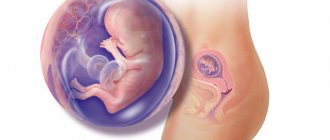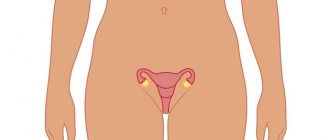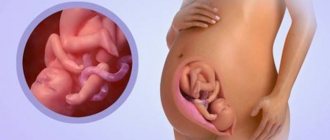Clinical picture
A small uterus can be discovered by chance, during a gynecological examination or on an ultrasound examination of the pelvic organs. A woman may not even suspect that she has a pathology. But in some cases, a trip to the gynecologist is caused by problems with the cyclicity of menstruation, when in adolescence girls do not have them, or the cycle does not stabilize for a long time.
The size of the uterus varies during certain periods of development of the female body. This reproductive organ grows as the girl matures, with active growth occurring during puberty. Development is influenced by hormones and the general condition of the body. The uterus reaches normal size by 16-18 years.
The size is determined by ultrasound examination and is: longitudinal 7-8 cm, transverse 4-5 cm. The thickness of the muscle layer is of great importance in order to get pregnant and bear a child; it should be within 2-3 cm. A decrease in these indicators can indicate about pathology. The size of the uterus may vary from girl to girl, depending on the constitution. So, short, asthenic girls may have a small uterus, but this will not prevent them from getting pregnant and carrying a child.
How does hypoplasia affect pregnancy?
In order for a girl to get pregnant, a small uterus cannot become an obstacle. But a disease of nearby tissues is something that may prevent fertilization or gestation. Although many doctors sound the alarm, citing the size of the uterus. Statistics show that most women, having a small uterus, carried and gave birth to healthy babies. There were even cases when a girl found out about the size of her organ only after she gave birth.
The only thing that can prevent you from getting pregnant is the presence of diseases of the organs located nearby. A common cause is, for example, kinking of the uterine tubes.
Types of small uterus
In gynecology there is no such diagnosis; there are pathologies of the development of the uterus and they are divided into the following types:
- hypoplasia
. The uterus is smaller, but not less than 5.5 cm; sometimes there is underdevelopment of other reproductive organs or hormonal imbalances; - infantilism
. The organ size of 3-5.5 cm corresponds to childhood, so it can be called “children’s uterus”; - aplasia
. The size is less than 3 cm, which corresponds to the uterus of a newborn.
Age-related features of the uterus
Diagnosis of uterine size
The doctor gets an idea of the size of the uterus based on an ultrasound examination. However, it is worth considering that diagnosis should not be limited only to this method. The small size of this organ does not always indicate the presence of pathology. A small uterus can be observed in women of asthenic physique in the absence of any problems in the reproductive sphere.
In addition to the ultrasound examination, a gynecological examination is performed. If the doctor detects a small height of the uterine fundus, this will confirm the diagnosis. Through a laboratory examination, it is necessary to determine the concentration of hormonal substances that are responsible for the development of the organs of the reproductive system, in particular the uterus. The uterine cavity is also examined.
Causes
The growth of the uterus can be impaired for several reasons. This is possible during the formation of organs (organogenesis) of the fetus or during puberty.
If hypoplasia or aplasia is detected, the reasons may be the following:
- body constitution.
In such cases, there are no disorders in other organs, the woman can conceive and bear a child; - pathology of fetal development.
It is observed if during pregnancy the mother of the child suffered from infectious diseases, did not eat properly, or was affected by other toxic, psychological factors. Perhaps this affected the child and caused developmental pathology; - disorders during puberty
. This is an important period in a girl’s development, so any stress, lack of nutrition and vitamins, as well as hormonal pathologies can lead to the development of hypoplasia.
Important!
The number of women with hypoplasia, infantilism or aplasia is growing every year. This is due to changes occurring in the environment (increased background radiation, pollution), changes in adolescents’ lifestyle and diet. Along with such pathologies, dystrophy, anorexia or obesity are increasingly common in adolescents. This is very dangerous for girls, especially during puberty.
Causes
A woman has a small uterus - its causes and consequences depend on the moment of its appearance. If during the prenatal period the mother’s body was exposed to vitamin deficiency, hormonal imbalance, the presence of infectious diseases or exposure to other unfavorable factors during the period of organogenesis, then this may be the cause of the development of genital abnormalities. If exposure to unfavorable factors: infectious diseases, diseases of the urinary and reproductive system, poor nutrition, hypovitaminosis, chronic fatigue or exposure to stress occurs during puberty, then the risk of developing a small uterus is also high.
We discussed why a small uterus causes infertility and miscarriage a little higher, but we’ll look at how its size changes during pregnancy below.
The uterus does not correspond to the gestational age: less, the reasons for this and the consequences? The doctor can judge the size and size of the uterus by the height of the fundus of the uterus, while a discrepancy in its size is physiologically allowed in women with a wide pelvis, when it is below average, and in women with a narrow pelvis, when it is larger. If the woman’s pelvis is normal, and the size of the uterus does not correspond to the gestational age, then the following pathologies need to be excluded:
- Intrauterine growth restriction
- Low water
- Incorrect gestational age
- Malpresentation of the fetus
- Small uterus revealed by ultrasound scan.
It should be understood that a difference of 3-4 cm from the norm is not a pathological condition. If a small uterus is detected already during pregnancy, cardiac monitoring and Doppler examination of blood vessels are required, which allows us to exclude pathology.
Is pregnancy possible?
How the diagnosis of a small uterus and pregnancy is consistent cannot be said unambiguously. Moreover, many women with this pathology become pregnant and give birth to children. There are also those in whom pregnancy occurs, but is interrupted. This can be explained by the fact that the uterus does not have time to grow and therefore rejects the fetus, or there are other hormonal disorders. In such situations, a woman does not have to terminate her pregnancy. Because hormonal changes during pregnancy promote the growth of the uterus, and this is better than hormonal therapy.
If a woman has aplasia, then most often it is impossible to restore her reproductive function; in such cases, IVF and carrying a child by a surrogate mother can be advised. In any case, you need to find out the cause and be treated; modern treatment methods can significantly change the prognosis for women with this pathology.
Diagnostics
Hypoplasia or aplasia of the uterus can be detected during a bimanual examination by a gynecologist or an ultrasound examination. Additional studies such as CT or MRI also help in diagnosing this pathology. But it is more important to identify the cause in order to prescribe the correct treatment.
Women with such pathologies are prescribed blood tests to determine hormone levels. When it changes, it is necessary to thoroughly investigate the reason that caused the increase or decrease in the concentration of hormones in the blood.
Important!
Hypoplasia or aplasia may be a sign of tumors of the pituitary gland or hypothalamus, which change hormonal levels and interfere with the normal development and growth of the uterus. If hormone therapy is carried out, it can accelerate the growth of the tumor.
Treatment
What to do if a small uterus is found on? You need to undergo examination by a gynecologist, endocrinologist and only then begin treatment. It happens that the examination reveals other pathologies of underdevelopment of the genital organs, or diseases that are the cause of infertility. Their treatment should be carried out in conjunction with hormone therapy, which is the most effective method for a small uterus.
Women usually find out that they have a small uterus either after an examination by a gynecologist in a chair, or after undergoing an ultrasound. Many of them hear the diagnosis at a fairly young age, others - after becoming pregnant. Some women are told that their uterine sizes are simply smaller compared to the norm, and some are given specific real diagnoses: hypoplasia, infantilism, aplasia. Very often, doctors scare young girls that they are unlikely to be able to get pregnant and carry a child in the future due to the fact that they have a small uterus; but also often women with such an anatomical feature easily become pregnant and give birth safely (and more than once) after undergoing hormonal therapy or even without it!
In general, we are leading to the conclusion that when a doctor says “you have a small uterus,” in absolutely every individual case it can mean anything: from a subjective visual assessment of the organ by a specific doctor to a very serious pathological condition in which infertility and miscarriage occur. . Therefore, it is impossible to measure everyone with the same standard, and such a diagnosis - a small uterus - does not exist in obstetrics and gynecology.
What treatment is prescribed for hypoplasia?
Hypoplasia is caused by a lack of hormones, hence the only method for treating it is to enrich the organ with hormones. Treatment by introducing hormones can be replaced by the usual intake of vitamins. In addition, the patient is prescribed physiotherapy, which consists of a slight tingling sensation in the lower abdomen.
Hypoplasia can also be treated with massage, stimulating the egg both externally and internally. This gives a rush of blood to the organ, which helps it enlarge.
Two popular methods can be distinguished:
- The first is laying down the clay. The clay is brought to a soft state (like wasabi) and applied to the lower abdomen. Cover the top with cling film and let it lie there for about two hours.
- The second effective way is sex. It simultaneously stimulates the uterus, providing a rush of blood to it, and in addition, promotes the production of hormones that the organ needs so much.
To use any of these methods, you must first consult your doctor.
Small uterus: causes, symptoms
The uterus of the average sexually mature woman usually reaches 7-8 cm in length, 4-5 cm in width and has a myometrial thickness of about 2-3 cm; The length of the neck is on average 2.5 cm. These dimensions are not standard, but normally doctors are guided by these parameters. Due to the anatomical and physiological characteristics of the body, a woman may have a normally functioning organ of a different size. Visually, a doctor can determine that a woman’s uterus is medium, large or small, but this is not about pathology in the structure and functioning of the organ. A small uterus is often found in fragile, petite, thin young ladies, which is explained by their configuration, body type, and physiology (accordingly, in large ladies it is often larger than average).
However, very often this definition means precisely the abnormally small size of the female organ, at which it is not able to perform the functions assigned to it by nature - to participate in the production of offspring. Pathologically, a small uterus is diagnosed with the following diseases:
- hypoplasia
- insufficient development of the female organ in size, accompanied by underdevelopment of other genital organs and hormonal disorders (such a uterus is equated in size to that of a teenager or a child); - infantilism (children's uterus)
is a pathology in which the size of the organ in a woman of childbearing age corresponds to the size of childhood (does not exceed 5.5 cm); - aplasia (embryo uterus)
is a pathology in which the size of an adult woman’s organ corresponds to its size in a newborn girl (does not exceed 3 cm).
As a rule, a small uterus is diagnosed during an ultrasound examination, the results of which are then interpreted by a gynecologist. The diagnosis is confirmed by the presence in a woman of at least one or more symptoms accompanying underdevelopment of the uterus:
- absence of menstruation;
- irregular menstrual cycle;
- painful menstruation;
- low sex drive;
- difficulties conceiving and/or bearing a child.
Doctors believe that disturbances in physiology occur either during the formation and formation of the female organ in utero (at the end of the first - at the beginning of the second trimester of pregnancy), or during the girl’s puberty.
In the first case, it may be infectious diseases suffered by the mother during pregnancy, hormonal imbalance, nutritional deficiencies, or her exposure to other unfavorable factors. Diseases (especially the genitourinary system, infectious viral diseases), insufficient or poor-quality nutrition, lack of vitamins and minerals, physical exhaustion, hard work, and stress can prevent the full growth of the uterus in adolescence.
A small uterus, which is the cause of underdevelopment, and not a physiological feature of the body, is almost always accompanied by other disorders, which individually and in combination with each other, one way or another, affect the conception and bearing of a child. Quite often, pregnancy with a small uterus becomes problematic if at the same time a hormonal imbalance is detected in the woman’s body, underdevelopment or pathologies in the structure of the cervix and fallopian tubes.
Causes of pathology
There are many reasons influencing the development of the reproductive system in adolescence. Doctors identify a number of congenital and acquired factors influencing genital infantilism:
- genetic disorders;
- exposure of the mother to harmful chemicals and poor lifestyle during pregnancy;
- infectious diseases of the mother during gestation;
- slow intrauterine development;
- dysregulation of the hypothalamic-pituitary system;
- past infectious processes;
- chronic extragenital pathology;
- diseases of the endocrine system;
- autoimmune disorders;
- hormonal disorders;
- underdevelopment of the ovaries;
- surgical interventions on the ovaries;
- excessive physical and mental activity;
- mental disorders;
- malnutrition and vitamin deficiency;
- ecology and lifestyle;
- heredity.
Suspension in the development of reproductive organs most often occurs due to congenital anomalies or hereditary predisposition. The most common causes are hypopolyvitaminosis and malnutrition, which results in stunted growth of the entire organism.
Surgeries on the ovaries can damage the reproductive organs; removal of the ovary indicates a decrease in hormonal levels, resulting in inhibition of the development of the reproductive system.
How to get pregnant if your uterus is small: pregnancy planning
Typically, women who have such an anatomical feature are worried about whether it is possible to get pregnant in this case, what to do, and what kind of treatment can be carried out.
If a woman is diagnosed with a small uterus and other problems of the reproductive system, then she will most likely have to prepare in a special way for the upcoming pregnancy. However, such preparation often does not provide for anything special.
In rare cases, to increase blood circulation and promote the growth of the uterine epithelium, a woman planning to conceive may be prescribed a special gynecological massage or physiotherapeutic procedures. Much more often, pregnancy planning with a small uterus takes place against the background of hormonal therapy. It usually happens that after a course of oral contraceptives, a woman becomes pregnant in the first or one of the next menstrual cycles after stopping OK. Together with other effects, hormonal drugs also contribute to an increase in the size of the organ. However, hormonal therapy for uterine hypoplasia can be prescribed only after a comprehensive examination of the woman’s health, because for some diseases that cause infertility, taking hormonal drugs is strictly contraindicated!
There are also frequent cases when pregnancy with a small uterus occurs only after vitamin therapy: as soon as the expectant mother takes vitamin and mineral supplements, balances her diet and optimizes her daily routine (lead an active lifestyle, but at the same time ensure adequate sleep and rest), the desired pregnancy occurs without any difficulties.
How to get pregnant faster with a small uterus
Long-term results obtained after the aftereffect period are, as a rule, better than immediate ones, therefore it is more correct to assess the effectiveness of physiotherapy taking into account the aftereffect period. The best ascending zodiac signs for conception are Taurus, Gemini, Cancer, Leo, Virgo and Libra.
but I’m afraid that uterine hypoplasia will not allow me to get pregnant or carry a child.. she said that pregnancy will benefit my small uterus.. Did your size quickly return to normal? The doctor told me that I urgently need to get pregnant, if this is still possible. Due to a lack of hormones, the uterus is small and the ovaries are large. Is it possible to get pregnant if your uterus is small? The female reproductive system is particularly vulnerable. And if it appears in it. Naturally, a woman can become pregnant in any position, but if... So, in some women there is a bend of the uterus, in others the cervix may. How to get pregnant the first time after 30. Is it possible to get pregnant if your uterus is small? The female reproductive system is particularly vulnerable. And if it appears in it. Does fibroid make it difficult to conceive, or can it cause infertility? Is it better to get pregnant, give birth, and then deal with fibroids, or vice versa? Girls, please tell me if it is possible to get pregnant with a polyp. I knew that the probability of getting pregnant with a polyp is very small... what size was the polyp and where exactly was it located in the uterus? Think about it. It seems to me that this way you will get pregnant faster and will probably get pregnant (if. Quite often, women are diagnosed with a small uterus. Is it possible to get pregnant with such a problem, carry and give birth to a healthy baby,.
Small uterus during pregnancy
It should be noted that a small uterus is not such a rare phenomenon. Women often hear similar conclusions addressed to them. True, we are not always talking about pathology and it is not at all necessary that a preliminary medical diagnosis will be reliable. Therefore, you should not be upset when you hear such a verdict. And you always need to confirm the gynecologist’s preliminary conclusion with an ultrasound examination, and also, possibly, visit not one, but several doctors.
Life experience shows that a small uterus and pregnancy are completely compatible concepts in a large number of cases. Moreover, just with the onset of pregnancy, many ladies find out that their uterus is small. Doctors reassure: it’s not scary, as the period increases, the organ will enlarge and grow along with the fetus, which is also facilitated by the hormones intensively produced by the female body during this period. But in order to reduce the risk of miscarriage and premature pregnancy due to insufficient uterine size, you may have to take hormonal medications and exercise increased caution on dangerous days for pregnancy.
In general, a small uterus in itself is neither a contraindication nor an obstacle to pregnancy.
And if, in addition to this feature, no other disorders have been identified in the expectant mother’s body, then we can hardly expect problems caused by this feature. Difficulties with pregnancy will most likely be associated with hormonal deficiency, thin loose myometrium, short uterine cervix and other features. The consequences of such deviations can be premature birth and miscarriages (miscarriage), difficult dilatation of the cervix during childbirth, and weak labor. But modern medical methods of pregnancy make it possible to minimize all risks and safely carry a baby even with a small uterus.
After childbirth, the uterus, enlarged during the period of bearing a child, will again regain its previous parameters. For many women who have given birth to a child or several, it remains small, like a nulliparous girl. Meanwhile, it happens that the pathology after childbirth disappears without a trace, and along with it other disorders: a small uterus, a bend of the uterus or fallopian tubes - everything returns to normal with the birth of the baby.
Be that as it may, you can get pregnant with such a pathology. Real difficulties arise mainly with a very small, completely undeveloped organ. And when aplasia is diagnosed, it becomes completely impossible to become pregnant naturally. But even in such situations, assisted reproductive technologies can help a couple become parents.
Especially for - Ekaterina Vlasenko
Surely every representative of the fair half of humanity will agree that gynecological problems always cause serious danger, since many of them directly affect the process of childbirth. Therefore, all women should pay close attention to their health and regularly visit a gynecologist. It is noteworthy that some diseases are congenital, and modern ecology often leaves much to be desired. The most common reason why a woman cannot get pregnant is the so-called small uterus.
Causes
Experts, as a rule, cite mechanical injuries to the abdomen received in childhood as the most common reason for this diagnosis. In addition, from the age of 11, when the body begins to develop at the hormonal level, this organ may also develop incorrectly. Various types of diseases that arise at this age, including infectious ones, are also dangerous. For example, the most common tonsillitis often leads to the diagnosis of “small uterus.” Moreover, improper development of the reproductive system can be observed with a lack of vitamins or microelements, which is why proper nutrition in adolescence plays an important role. A small uterus is often formed when the ovaries are underdeveloped. They, in turn, are not able to produce the required amount of hormones, and as a result, the process of direct maturation of the egg is disrupted.
Little uterus. First signs
By what symptoms can a young girl suspect this diagnosis? Firstly, during the first mandatory examination by a gynecologist. The doctor will visually determine that the girl’s vagina is of irregular shape. In addition, tortuous fallopian tubes with the presence of lumens in them will also indicate the presence of the above-mentioned diagnosis. Often, scanty periods, irregular cycles, and severe pain during menstruation signal possible problems.
Little uterus. Treatment with hormone therapy
Experts say that the development of the uterus is directly influenced by the hormones themselves. So, if a woman lives a constant sex life, then there is a high probability that changes will happen on their own. Taking into account the fact that a child’s uterus, the treatment of which is often not started in a timely manner, appears due to a lack of hormones, therapy should be related specifically to them. Of course, in this case the treatment will be quite long, but, on the other hand, you will be pleasantly rewarded.
Physiotherapeutic procedures
Doctors often prescribe special procedures for this diagnosis, the purpose of which is to improve blood circulation in this area. It is noteworthy that the uterus very quickly returns to its normal state with regular exposure to current or massage on the lower abdomen. It is important to note that in this case, you will most likely need a course of vitamins necessary for the normal functioning of the entire body.
After the initial examination, the gynecologist may make a diagnosis of “hypoplasia of the uterus” or its underdevelopment. Is it possible to get pregnant with a child's uterus, especially when there are problems with hormonal levels? A small or underdeveloped muscle “bag”, which is determined by nature to bear the most precious things, is an unpleasant diagnosis. It is detected by pulpation (palpation) and clarified by ultrasound. Is this a feature or a pathology? How to solve the problem of conception and pregnancy in order to give birth to a full-fledged baby - every girl with a similar diagnosis should know about this.
Treatment for abnormally small uterus
Treatment begins with determining the causes of the development of such pathology.
First of all, hormonal drugs are prescribed in order to normalize female hormones in the body. Additionally, vitamin and mineral complexes are prescribed. External and internal massage of the reproductive organs by medical specialists promotes an increase of 1-2 cm by improving blood circulation. Physiotherapeutic procedures (paraffin therapy, mud therapy, UHF) are recommended. Such actions reduce the likelihood of ectopic pregnancy and contribute to successful pregnancy.
It has long been proven that the emotional component during pregnancy is a very important factor. Therefore, you should not worry if you are diagnosed with a small uterus; according to statistics, pathology is not the main cause of infertility. After fertilization of the egg, the reproductive organ will adapt to the needs of the child, stretch and preserve the fetus inside the womb as much as possible, and doctors will help to avoid complications.
Is it possible to get pregnant if your uterus is small?
The female reproductive system is particularly vulnerable. And if any disease appears in her, then this poses a serious danger both to the health of the woman herself and to her unborn baby. Therefore, the fair sex needs to take good care of their body, take care of it and periodically check it with a doctor. However, no matter how careful you are about your health, some aspects of it still do not depend on you. Therefore, for many women, such a diagnosis as hypoplasia becomes surprising.
In simple terms - “little uterus”. Unless, of course, the girl herself stands out for her height, then, in general, there is nothing to worry about. But if, on the contrary, you are of average height, and doctors, when they say the word “small,” make a concerned face, then there is something to think about.
What is a “baby” uterus?
The diagnosis of “uterine hypoplasia” or the term “baby uterus” is well known not only to gynecologists, but also in circles planning pregnancy.
However, there are often cases when uterine infantilism or underdevelopment of this organ is diagnosed incorrectly. With late maturation, further formation of reproductive organs is still possible, if this is not a congenital pathology. Therefore, it is not surprising that young women find out on the forms - is it possible to get pregnant with a child’s uterus? Adult women often face a “childish” problem - this is what the uterus of sexually mature women is called if it does not meet the norm and age standards. Of course, in medicine the concept of “norm” is relative or conditional. And with different shapes and sizes, it combines several different pathologies, conventionally called “children’s uterus”.
Is it possible to become pregnant with a diagnosis of “baby uterus” if a woman is afraid of it as a death sentence? The psychological component also plays an important role, and all organs and functions in the body are interconnected. Often girls who have problems with “imperfection” go to extremes, driving themselves to exhaustion.
Mental immaturity and unwillingness to take responsibility for one’s health go hand in hand. Look at the girls suffering from extreme exhaustion due to anorexia - how could there be a normal uterus and the ability to give birth? Of course not! But ordinary girls who have not had problems with diets also often have this diagnosis, although persistent “drying” of the body may not affect reproductive function in the future.
A normal uterus is a guarantee of the opportunity to give birth to your own children without resorting to outside help. Pathologies of the reproductive organs were once regarded as a punishment from above, a curse or a sentence. However, in the time of our grandmothers, they tried to be treated with folk remedies, prayed and believed in the best. We live in an age of advanced technology, so any diagnosis is not considered critical, especially if you really want to have a child. Yes, you can get pregnant with a child’s uterus, depending on the stage of deviation from the norm.
What are the forms of uterine underdevelopment?
Purely theoretically, uterine hypoplasia is not a disease, but a minor pathology in which an important female organ has not reached normal.
This is quite arbitrary, but a “children’s” uterus is a definition relative to the age and body proportions of an adult woman. Perhaps this is a hereditary factor or for some reason some organs stop developing at a certain stage. A child's uterus is a general concept for several diagnoses, but based on the name, it is clear that it has not reached full development. In some nations, as a preventive measure, girls are well fed (especially with milk and honey), for example, in Mauritania. There, potential suitors suspect a child's uterus in every thin girl with unexpressed breasts. Is it possible to get pregnant with a diagnosis of a baby uterus and small breasts? They are sure that such women are not capable of full pregnancy. Unfortunately, such a diagnosis is not uncommon in our country.
It is more difficult for an infantile or shortened uterus to hold the implanted fertilized egg and stretch to normal levels in order to give birth to a baby at 9 months. Doctors have a scale of conformity, where the “norm” is considered to be a uterus of at least 5.4 cm in height and 4.3 cm in width.
Those who were diagnosed with this problem when dealing with a problem with conception were most likely found to have a disproportionately small organ. In this case, the cervix of a miniature uterus can be of normal shape, and the muscle sac itself is compacted and small in size. Doctors define subtypes:
- Uterine infantilism;
- Hypoplasia of the uterus.
Infantilism is often accompanied by scanty periods and cycle abnormalities.
Such a uterus is shortened and compacted, but with a fairly long neck, it emerges as a conical vagina, the pharynx is pinpointed, very small. This makes fertilization difficult, but pregnancy is possible after a series of procedures. Sexual infantilism with an underdeveloped uterus is often accompanied by dysfunction or polycystic ovaries, and other signs are possible. This is not obvious from the size of the external genitalia; most often there are hormonal abnormalities. But with a stable sexual life and well-chosen therapy, stimulation of reproductive function is possible. Such women have scanty menstrual flow, and cyclicity begins late. Genital infantility is classified according to the degree of development:
- Embryonic (uterus up to 3 cm).
- Actually infantile or children's uterus (up to 5.5 cm).
- Teenage (5.5 – 7 cm).
In medical practice, there are different cases, but for them the overall state of the woman’s reproductive system, her physiological readiness for pregnancy and childbirth are more important.
The diagnostic determination is not so important when a woman has a child’s uterus, the main question is - is it possible to get pregnant with it? Here it is important not only physiologically, but also psychologically to prepare the patient for a long rehabilitation process. The worst thing is when a girl “withdraws into herself”, withdraws and becomes depressed, not wanting to be treated in order to get rid of her inferiority complex.
What determines the course of treatment for uterine pathologies?
How to get pregnant with a baby uterus, if this is influenced by a number of factors:
- genetic;
- congenital;
- acquired.
Genital infantilism can be caused in utero, when there are chromosomal and genetic abnormalities.
Also, in “harmful” production, repeated mutations associated with professional activities occur. Intrauterine growth retardation is influenced by bad habits or addictions, especially when a girl is already pregnant, but cannot decide whether she needs a child. In a toga, pregnancy ends with childbirth, and the baby has a number of congenital pathologies, including an infantile uterus.
The size and shape of the uterus change in their own way during childhood. A newborn baby’s uterus has already formed and is quite large – up to 4 cm. During normal development, it shrinks slightly and for several years it is no more than 2.5 cm in length.
At school age, all reproductive organs actively develop until the uterus reaches mature parameters. It is approximately 6-8cm in length with a width of 4-6cm. With this size, the girl enters the fertile phase. The uterus is somewhat reminiscent of an iceberg - most of it is not visible, two-thirds is hidden in the abdominal cavity.
Probability of treatment for different degrees of pathology
When a woman’s uterus is small, characterized by varying degrees of deviation, doctors have different assessments of the prospects for therapy for infertility with hypoplasia:
- At degree 1 (virgin uterus, up to 7 cm), underdevelopment is considered insignificant. Upon entering sexual activity, the size of the organ increases slightly, conception is possible, and after childbirth it reaches normal limits.
- In the 2nd degree (children's uterus, 3-5.5 cm), its size lags behind the norm, the ovaries are displaced, the fallopian tubes are thin, long and curved. Women with such hypoplasia have scanty and painful periods and begin later than other girls.
- At the 3rd degree (embryo uterus, up to 3 cm) a complex form of genetic pathology, when development is slowed down or stopped at the intrauterine stage. The uterus is thin, elongated, more like a dead-end cervix, it is not adapted for pregnancy and childbirth.
Sometimes the problem resolves on its own due to lifestyle changes.
For example, switching to a normal diet after active sports activity and an imposed diet. When a growing body lacks protein or “building material,” it takes nutrition to form vital organs. Vegetarians are also susceptible to vitamin deficiencies, protein starvation and hormonal abnormalities - small breasts, poorly functioning ovaries, and the uterus does not grow. As you know, the uterus is not just a muscular sac; it is involved in hormonal metabolism and the transport of sperm to the egg. It forms the endometrium - a nutrient medium for the embryo, and this is the main place of its implantation. This is where the active growth of the egg occurs after fertilization. The condition of the uterus affects many processes of the endocrine system; it ensures a regular cycle and women's health in general. On women's forums they often write reviews about a child's uterus - it turns out that you can give birth with an infantile organ. This is a unique organ - before childbirth it increases many times and can weigh up to 1.5 kg. The muscle fibers stretch up to 35 cm, covering a large fetus, while it is located in the abdominal cavity, so that the embryo fully develops, and the gastrointestinal tract organs develop safely, although they put pressure on the bladder and intestines. After childbirth, during breastfeeding, the uterus contracts and gradually returns to normal. However, the uterus of women who have given birth is larger than that of virgins, and its size can be determined by intravaginal ultrasound or by palpation.
When the muscle sac contracts well, childbirth takes place safely, without complications. Before menopause, fibroids and other tumor processes can form in the uterus (due to hormonal imbalance), and the organ takes over the tumor processes, most often without degeneration or oncology. Therefore, the interest of women with pathologies is fair: how to get pregnant with a child’s uterus?
Attention: Doctors state that with a significant deviation and abnormal development, fertilization is complicated and full pregnancy is excluded. With moderate uterine hypoplasia, long-term treatment is carried out.
With a slightly underdeveloped uterus, conception is possible after several months (years) of sexual activity; after the first pregnancy and childbirth, it returns to normal. In women who have given birth, the length of the uterus reaches 8-9 cm, width - 5 cm, wall thickness - within 30-50 mm. During menopause, there is a hormonal imbalance, the size of the uterus can vary, and most often it dries out. But before menopause, women who have had problems with infertility “unexpectedly” become pregnant due to hormonal surges.
Is it possible for a woman to give birth with a baby's uterus if she undergoes treatment?
Modern gynecology solves many problems associated with deviations from the norm.
Doctors are often asked when a woman has a baby’s uterus - is it possible to give birth? If the body has “gave the go-ahead” for conception with slight hypoplasia of the uterus, most likely it is ready for childbirth. Congenital abnormalities give less chance. If there was an injury that damaged the pelvic organs, it is better not to plan a pregnancy. But in all other cases, when the “virgin uterus” is small in size, the chances of having a baby are high. In case of hormonal dysfunction, you need to undergo a course of treatment, which will be prescribed by a female doctor, determining the shape of the uterus and the degree of development. If you are underweight (fasting, dieting), it is important to first normalize your weight.
Excessive physical or emotional stress, mental disorders, drug (other) addiction - all this must be eliminated as a source of pathology. After a long course of rehabilitation after acquired hypoplasia, you can give birth with a baby uterus. But not only problematic childbirth is a consequence of acquired hypoplasia. Such women have reduced libido (no expressed sexual desire, lack of orgasm). Therefore, you should not isolate yourself and be offended by the whole world. It is better to bring your life back to normal, consult a doctor to undergo treatment and find the happiness of motherhood. Be healthy!
A small uterus can occur as a symptom in various forms of sexual infantilism and in hypogonadism.
What should those with a small uterus do? Is it possible to get pregnant in such a situation?
Causes of a small uterus
- Hypogonadism is insufficient development of the genital organs due to low concentrations of sex hormones in the blood, starting from a very early age.
- Genetic abnormalities and intrauterine developmental disorders of the uterus.
- Chronic intoxication that occurs in childhood and prevents the genitals from developing normally. The cause may include alcohol, drugs, and some potent medications.
- Lack of nutrition and vitamins.
- Rheumatic diseases and chronic diseases of the respiratory, cardiovascular and digestive systems.
Symptoms of a small uterus
As a rule, a small uterus itself does not cause any problems for a woman.
She does not feel any discomfort and leads a normal sex life. But at the same time, difficulties often arise with conceiving a child or carrying a pregnancy. It is these problems that force the patient to see a doctor. The disease is detected when determining the causes of infertility or miscarriages.
In some cases, this defect in the woman’s reproductive system is accompanied by certain symptoms that the patient can pay attention to. May have dysmenorrhea
– painful menstruation and disturbances in general condition during them.
If a small uterus is a symptom of hypogonadism, then the woman will have other manifestations of this condition. This term characterizes a low level of sex hormones in the blood. This is usually a consequence of ovarian failure (primary hypogonadism) or pituitary gland (secondary hypogonadism).
Associated symptoms:
- narrow pelvis;
- underdevelopment of all genital organs;
- a small amount of hair on the pubis and armpits;
- male-type fat deposition - on the abdomen;
- small size of mammary glands;
- irregular cycles or amenorrhea.
Get an expert opinion
Leave your e-mail and we will tell you how to get properly examined and begin treatment
Symptoms of uterine hypoplasia
A small uterus rarely manifests itself in the form of any symptoms, so women may not be aware of this abnormality in themselves. There is no clinical picture if the reduced size of the reproductive organ is insignificant and due to physiological characteristics.
Baby uterus is usually observed in petite and thin women with short stature.
A child's uterus can be suspected based on several signs that occur in girls during adolescence:
- Severe abdominal pain during menstruation.
- Headaches, nausea, severe deterioration in health during menstruation.
- Excessive thinness, absence or underdevelopment of the mammary glands.
- Absence of menstruation until age 16 or more.
- Frequent delays in menstruation.
- Lack of secondary sexual characteristics.
A general examination reveals that the girl is lagging behind in physical development: thinness, short stature, slight pubic and armpit hair, narrow pelvis, underdeveloped mammary glands. During a gynecological examination, the following signs are determined:
- Undeveloped labia, open clitoris.
- Reduced ovaries.
- Short and narrow vagina.
- Tortuous fallopian tubes.
- Irregular structure of the cervix.
- Unnatural size and bending of the uterus.
Women of reproductive age with a child's uterus usually complain of non-occurrence of pregnancies, frequent miscarriages, inability to have orgasms, decreased libido, chronic recurrent cervicitis and endometritis, etc.
The extent to which uterine infantilism is expressed is determined by the results of the examination:
1st degree – rudimentary uterus, abnormal development of the uterus.
- The most severe but rare form.
- The uterus is extremely undeveloped, its size is no more than 3 cm (including the cervix).
- No menstruation.
- Treatment is practically ineffective.
2nd degree – underdeveloped uterus.
- The size of the uterus is more than 3 cm.
- The cervix is three times longer than the body of the uterus, which corresponds to the period before puberty.
- Treatment is possible, but must be long-term and regular.
3rd degree – uterine hypoplasia
.
- The size of the uterus is up to 6-7 cm.
- The ratio of the cervix to the body of the uterus is normal.
- It often heals on its own with regular menstruation and proper ovarian function.
How to determine hypoplasia?
If you diagnose without the help of a doctor, then the only way is to observe the discharge during menstruation. If they are small, and the cycle itself is constantly disrupted, then this can be attributed to a sign of hypoplasia. But the final conclusion will be made by the doctor.
Having carefully examined the shape of the vagina, the condition of the fallopian tubes and the presence of gaps between them, the gynecologist will accurately make a diagnosis. A healthy uterus should not exceed 8.4 centimeters in length and 6.2 centimeters in width. The standard dimensions for the cervix are 2.5 to 3.5 centimeters. If the sizes do not match, then this indicates a violation of the growth of the uterus.









